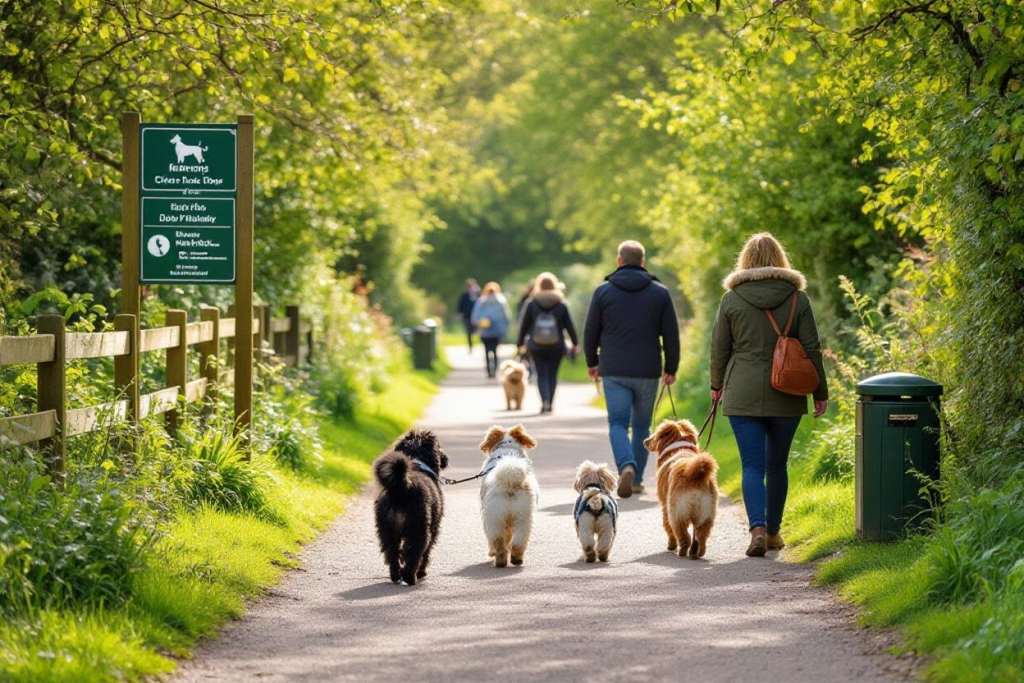Walks around Wetherby give you beautiful, varied options for dog-friendly walks Wetherby and the best dog walking routes Wetherby, but you must watch for ticks, grazing livestock and busy roads. Your local vet helps you keep your dog safe with practical vaccinations and ongoing parasite prevention, so you can enjoy routes with confidence and know when to seek veterinary care.

Unveiling Wetherby’s Dog-Friendly Gems
Wetherby serves up a compact mix of green spaces and riverside routes that suit every dog and walker, from short town strolls to longer country jaunts; popular picks include Wetherby Ings meadows and footpaths into Bramham Park, both offering off-lead stretches and 2–4 mile loop options. You should plan around busy roads near the town centre and keep parasite protection current—ticks thrive in long grass, so check your dog and consider our parasite prevention.
Scenic Parks and Nature Reserves
Wetherby Ings gives you wide, flat meadow paths ideal for recall training and puppy socialisation, while nearby Bramham Park provides mapped public footpaths through parkland and ancient trees; typical walks range from 1–3 miles, making them great for regular daily exercise. You should avoid fields with grazing animals or follow on-lead signs, carry water in summer, and check vaccination status at our vaccinations page if you plan group meet-ups or kennels afterwards.
Riverside Strolls and Trails
The River Wharfe towpath from Wetherby offers flexible routes—short 30-minute stretches by the town or longer 3–5 mile (5–8 km) out-and-backs toward Boston Spa—featuring gentle terrain and plentiful sniffing spots. Keep dogs away from steep banks and areas near locks, and be alert for ticks in long grass and occasional flood debris; for parasite control advice see this guide.
For practical planning, park at Wetherby market car park for easy access to the towpath, then follow the Wharfe north for roughly 1.5–2.5 miles before turning back to make a 3–5 mile loop depending on your dog’s fitness. Steep banks and fast water near some bends present water-safety hazards, so use a long line for dogs with poor recall and carry a basic tick removal kit and the number for out-of-hours care (emergency vet) if you spot signs of bite, limp, or sudden illness.
Protecting Your Pets: Essential Safety Measures
Keep your dog microchipped and wearing an up-to-date ID tag, carry water and a basic first-aid kit, and use a short lead near roads or livestock. Maintain vaccinations and tailor parasite protection to Wetherby conditions — see your vet for guidance on parasite prevention and current options. Inspect paws after walks for cuts or burrs, note any limping, and act fast if you spot signs of heatstroke, severe bleeding or sudden collapse.
Navigating Tick Risks in Wetherby
Ticks thrive in woodland, long grass and riverside vegetation along the River Wharfe, with activity highest between April and October and peaking May–August; check your dog within 24 hours of every walk. Remove ticks promptly with a proper tick tool or fine tweezers, grab the head close to the skin and pull straight out. Ask your vet about effective repellents or systemic preventatives that significantly reduce tick attachment and lower the risk of Lyme disease.
Awareness of Local Wildlife and Roads
Open fields around Wetherby host sheep and cattle, especially during spring calving, so keep your dog on a short lead near livestock and ground‑nesting bird areas to avoid disturbance and potential injury. Busy routes like the A1(M) and A168, plus narrow country lanes, demand extra caution—use reflective collars, hi‑vis leads at dusk, and keep recall reliable to prevent dogs running into traffic.
During breeding season (March–July) avoid letting dogs chase lapwings, curlews or geese; disturbance can cause nest abandonment. At riversides, swans and adult geese may become aggressive—give a wide berth and secure your dog if waterfowl approach. When passing livestock, step to the nearest verge, shorten the lead to under 1 metre, and move calmly past; if livestock behave nervously, back away and find an alternate route to reduce risk to your dog and the animals.

Vital Vet Insights: Mandatory Vaccinations and Parasite Control
To keep your walks around Wetherby safe, maintain up-to-date core vaccinations and a tailored parasite plan covering ticks, fleas and worms; gaps raise the chance of serious illness on rural routes and riverbanks. You should link vaccine status to specific activities—boarding, classes or river swims—and log treatments so you can prove protection quickly if you need emergency care after a walk. For practical guidance see our parasite and vaccination pages below.
Key Vaccinations for Wetherby Adventures
Core protection routinely includes distemper, adenovirus (infectious hepatitis), canine parvovirus and parainfluenza, with leptospirosis commonly added in the UK; puppies typically start at 8–9 weeks with a second dose at 12 weeks and a booster at 12 months, then either annual or triennial boosters depending on product. Kennel cough (Bordetella) is recommended if your dog meets many others on the best dog walking routes Wetherby. Full vaccine details: Vaccinations.
Effective Parasite Prevention Strategies
Ticks from Wetherby woodlands and river margins transmit pathogens such as Lyme disease, so use year‑round tick control and combine monthly oral or spot‑on products or long‑duration options (oral fluralaner up to 12 weeks, afoxolaner monthly, Seresto collar up to 8 months) to match your walking habits; check your dog thoroughly after each walk and remove ticks within 24–48 hours to sharply reduce transmission risk. Read more: Parasite Prevention.
After busy routes like riverside trails and fields, inspect common attachment sites—ears, neck, armpits, between toes—and keep a tick remover or hook in your walking kit; pull steadily without twisting and disinfect the bite. Treating for tapeworm with praziquantel after swimming or prey ingestion and arranging annual faecal worm egg checks gives extra protection, while recording product names and dates helps you manage renewals and supports swift action if symptoms appear during a dog walk in Wetherby.

Future-Proofing Your Dog’s Health: Seasonal Considerations
Plan for seasonal shifts to keep your walks in Wetherby safe and enjoyable: ticks peak April–September (especially May–July), mud and river flooding follow heavy rain along the Wharfe, and warmer months raise heat-related risks. You should keep vaccinations and parasite protection updated, check local forecasts 24–48 hours ahead, and adapt route choice among the best dog walking routes Wetherby offers to avoid hazards and crowded events.
Preparing for Weather Changes
On hot days aim for pre-10am or post-7pm walks, carry water for you and your dog, and shorten outings when temperatures exceed 20°C; on icy mornings protect paws from salt and ice with booties or balm and keep walks shorter and on-lead. After heavy rain avoid low-lying areas like Wetherby Ings where river levels rise quickly, and have a waterproof coat and towel ready for muddy returns.
Adjusting Walks Based on Local Events and Conditions
Check the Wetherby Racecourse fixture list and the town events calendar before heading out—race days, markets and shows draw large crowds and can mean busy car parks and stressed dogs; pick quieter trails or fields on those dates, keep your dog on a lead near livestock, and plan alternate dog-friendly walks Wetherby routes to reduce risk of escape or agitation.
Practical steps include subscribing to local event pages and the racecourse website, using weather apps for flood alerts, and mapping two backup routes: one riverside quiet path and one higher-ground field route. If fireworks or large agricultural shows are scheduled, walk early and check your dog’s microchip and ID, update parasite prevention (see https://yfvets.co.uk/parasite-prevention-and-control-at-your-family-vets-knaresborough/) and vaccinations (https://yfvets.co.uk/vaccinations/) ahead of busy seasons, and know where emergency care is (https://yfvets.co.uk/emergency-vet-harrogate-and-york-when-to-call/) if a situation arises.
Final Words
Ultimately you can enjoy the best dog walking routes Wetherby offers while keeping your dog safe by choosing suitable dog-friendly walks, checking for ticks, avoiding livestock and busy roads, and keeping vaccinations and parasite prevention up to date; book a consultation with your local vet for tailored parasite control at https://yfvets.co.uk/parasite-prevention-and-control-at-your-family-vets-knaresborough/.
FAQ
Q: Why is Wetherby a great place for dog walks?
A: Wetherby offers varied dog-friendly walks — riverside paths along the River Wharfe, open greens such as the Ings, quieter country footpaths and nearby estate trails — making it ideal for short local strolls or longer exercise. The mix of off-lead space, café stops and parkland means dogs of different ages and energy levels can be catered for, and the proximity to nearby towns gives options for changing routes depending on weather and activity level.
Q: What are the top dog-friendly walking routes around Wetherby?
A: Top options include the Wetherby Ings and riverside loop for easy, scenic walking; perimeter routes around local parks and the racecourse for varied terrain; nearby estate and woodland trails (check individual site rules for dogs and seasonal restrictions); and public footpaths linking local villages for longer hikes. For more regional routes and ideas, see related local walks in Harrogate for inspiration: https://yfvets.co.uk/top-10-dog-walking-spots-in-harrogate/.
Q: What safety issues should I watch for on dog walks in Wetherby?
A: Key hazards include ticks in long grass and woodland (practice tick prevention Wetherby-style and check dogs after walks), livestock where dogs must be kept on leads, busy roads and cyclists at path junctions, and seasonal dangers like frozen surfaces or heat on hot days. Carry water, a basic first-aid kit, a tick removal tool, and a phone. If an animal is clearly injured, poisoned, collapsed or showing severe distress, seek veterinary help immediately: https://yfvets.co.uk/emergency-vet-harrogate-and-york-when-to-call/.
Q: What vaccinations and parasite prevention should my dog have before walking locally?
A: Ensure core vaccinations are up to date (distemper, parvovirus, hepatitis and leptospirosis where recommended) and discuss regional risks with your vet: https://yfvets.co.uk/vaccinations/. For ticks, fleas and intestinal worms, use year-round preventative treatments tailored to local tick risk — topical or oral options and regular worming for pasture exposure. For detailed parasite control options and to book a tailored plan, see: https://yfvets.co.uk/parasite-prevention-and-control-at-your-family-vets-knaresborough/.
Q: When should I contact my vet after a walk and how can I arrange parasite control?
A: Contact your vet if your dog shows unusual lethargy, lameness, swelling, fever, persistent vomiting/diarrhoea, signs of tick-borne disease after a tick bite, visible wound or suspected poisoning. For urgent collapse or severe breathing difficulty call emergency services and an emergency vet immediately: https://yfvets.co.uk/emergency-vet-harrogate-and-york-when-to-call/. To reduce the chance of post-walk problems, book a parasite-control consultation or vaccination appointment with your practice: https://yfvets.co.uk/parasite-prevention-and-control-at-your-family-vets-knaresborough/.

